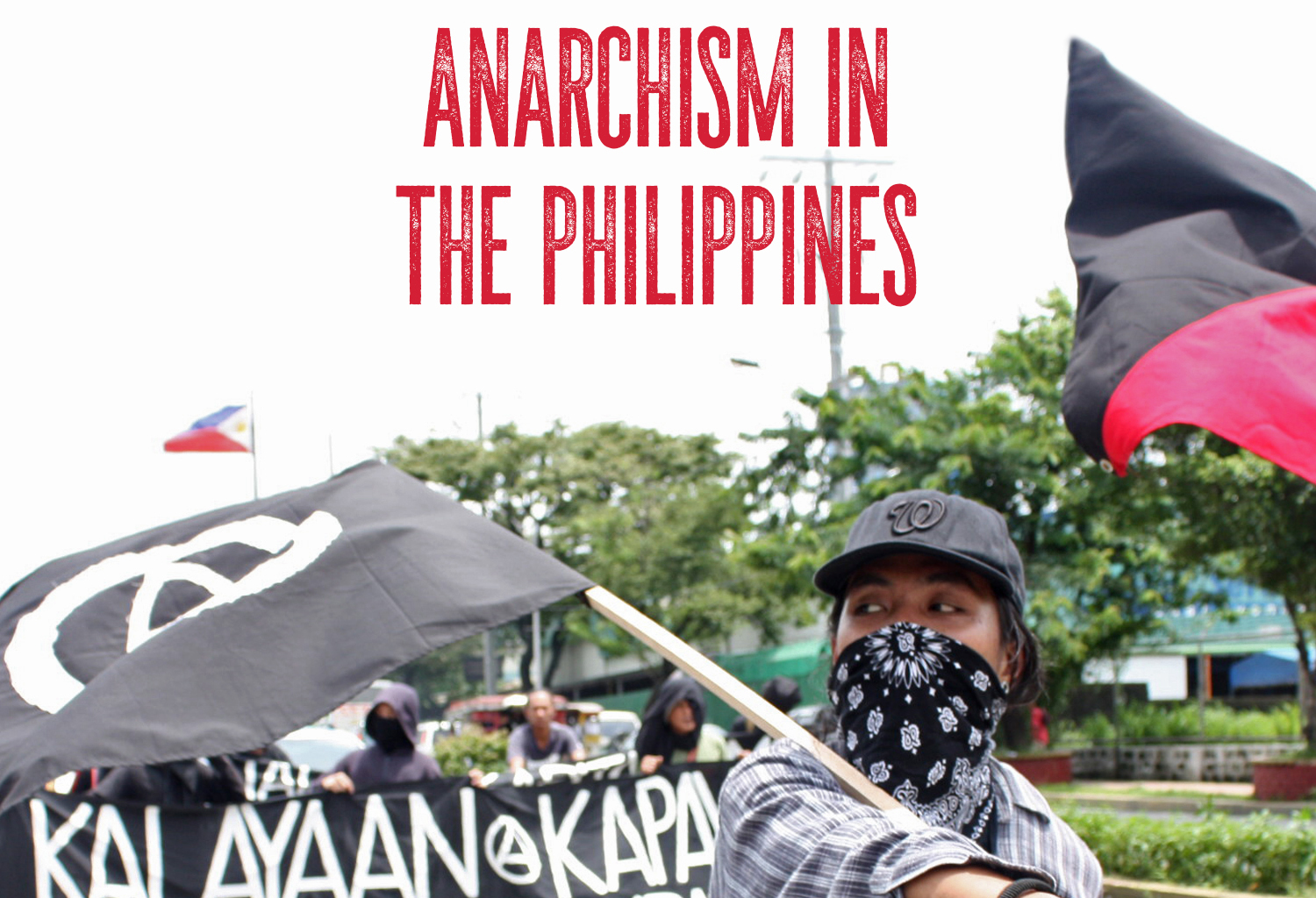By Claudia C. Lodia, San Francisco State University
Anarchist Developments in Cultural Studies
May 2021
A succinct account of the significance of anarchism in the Philip- pines, Bas Umali’s Pangayaw and Decolonizing Resistance: Anarchism in the Philippines begins with a chat in a sidewalk café in Malate be- tween the author and Gabriel Kuhn, the book’s editor. Their conver- sation, which involved commiserating with a group of young punks about the “Sagada 11” arrest, transpired from Kuhn’s first meeting with Umali’s friend, Jong Pairez, in 2006 (the Sagada 11 are a group of Food Not Bombs volunteers accused of attacking a military out- post in Makyan, a municipality in the province of Benguet in the Cordillera Region). Fifteen years passed, and the three had remained in contact through international networking and collaborative writ- ing and fundraising projects.
The book is divided in two major sections. The Introductory sec- tion includes an interview with Pairez and Umali and a chapter, “Sketches of an Archipelagic Poetics of Postcolonial Belonging,” by Marco Cuevas-Hewitt. The second section consists of five chapters by Umali, including an extended chapter, “Pangayaw: Decolonizing Resistance in a Network of Communities in the Archipelago,” intro- ducing pangayaw as a method of decolonizing.
In the introduction, Umali and Pairez offer an account of the an- archist movement in the Philippine archipelago – its emergence, conceptual assumptions, and survival. Both observe that the recent search for “an alternative form of struggle that veers away from the traditions of the dominant Philippine Left” (12) represents an impor- tant intervention in the archipelago’s political patterns. The influence of the authoritarian Left – the National Democratic Front (NDF) which was facilitated by the Marxist milieu of the Communist Party of the Philippines (CPP) – historically aimed, in competition with the nationalism of the central government, to build a nationalist ide- ology that would be unified under a homogenous conception of the “authentic Filipino.” It is from within such centralizing/nationalistic emerge. Kuhn refers to a CNN Philippines article by Portia Ladrido:
For these anarchists, while they may come from different interest groups, they all form the same basic principles of “true” anarchism: that anarchism values the capacity of the individual to organize itself; that anarchism sees the role of the individual as a tool that contributes to a larger community; that anarchism is about mutual aid, directly helping any soul in need; and that anarchism is about the belief that humans are wired to pursue the common good, regardless of an authority figure. (8)
Decentralization and diversity are important recurring themes throughout the book. Conjuring phrases such as “tribes with their own self-identity, culture, and sociopolitical organization,” or “cul- tures produced in flows,” or terms — “assemblies,” “rooted complex- ity,” and “archipelagic networks” — signal not only the egalitarianism and interdependence uniting the archipelago’s tribes and barangays (municipalities, which are the Philippines’ smallest governing units), but also the profound intimacy linking Indigenous communities with practices of direct action. The book’s central project, in my view, is its call for an archipelagic confederation, which Umali defines as
“a structure that connects and interlinks politically and economically every community in the archipelago from the grassroots level on the basis of mutual cooperation, complementation, and solidarity” (49). Indeed, the objective of an archipelagic confederation is to create a structure that will facilitate a return to pre-colonial free assemblies and disrupt reliance on political parties that are inherently centralis- tic, top-down, and divisive, as people are subsumed into being obe- dient followers of this or that organization. This defense of a return to free assemblies is not a renunciation of order. Rather, it is a resis- tance to the current order that disregards the value of maximizing local networks and the unique knowledge they produce with respect to the peoples’ needs and interests.
The essay on “Reconnecting Traditional Links,” further signals the established macrosocial connection between the Philippine archipelago, Malacca, Indonesia, Malaysia, Thailand, and other communi- ties in Southeast Asia, while elucidating paternalistic and nationalist forms of discipline as a mechanism to suppress the centrality of local tribal relations and ecologically sound Indigenous negotiating pro- cesses. The author cites the 2013 Sabah crisis, when Tausūg warriors attempted to reclaim traditional territories in North Borneo now occupied by Malaysia, as a case in point. A territorial dispute was aggravated by and negotiated through statist politics and nationalist scripts.
The deep connectivity between archipelagic communities requires a preliminary definition of “archipelago,” and this is the purpose of Cuevas-Hewitt’s “Sketches of an Archipelagic Poetics of Postcolonial Belonging.” Not only is this an incisive analysis of the development of the modern nation-state-centric view of islands as insular and bounded entities: it functions equally as an earnest reflection on the “complex connectivity” (27) between and among islands thanks to the sea.
The importance of the trope of the archipelago is exactly this; that it shifts attention away from compartmental- ized island space and redirects our gaze toward the relational space of the sea… what is significant about the archipelago is the sea between – a site of a multiple series of relations that are never fixed but constantly in flux. (29-30)
The sea, through its movements and flows, touches each island, and facilitates the sharing of the power of the sea. Weaving localities without imposing uniformity, the sea enriches, not erases, the local; and the multitude of locals making up the archipelago enrich the sea in return. Exploring the poetics of the archipelago, in Cuevas- Hewitt’s words, “makes explicit that which is already implicit” in sociality. (31)
The book concludes by bringing our attention to pangayaw – a practice most feared by the Spanish colonizers, which was essential to the politics and self-determination of barangays and Indigenous communities in the archipelago. A pangayaw is distinguished by its spontaneity: it consists of a sudden attack or “a raid on land or sea in order to defend, avenge, or settle a dispute – not to establish cen- tral power” (92). The word has cognates throughout Mindanao and Visayas (two island groups within the Philippine archipelago) and reaches all the way to Southern China. Umali emphasizes that the strategic reproduction of inequality by super-institutions makes it difficult to recognize coloniality because inequality has been dis- guised as a cultural and social fact. This is an effect of propaganda which must be attacked: “To engage in decolonization means to engage in war. Our age is the age of the propaganda war. We can use pangayaw to engage in a propaganda war against centralized institu- tions” (95). Throughout, Umali, references instances of pangayaw countering state rule, including the historical victory of Lapu-Lapu in 1521; Tamblot’s revolt (1621); the Waray-Waray revolt (1622), and resistance struggles in Pangasinan and Pampanga in 1660, in Iloilo in 1663, in Bohol in 1744, and in Ilocos Norte in 1807. Shar- ing these inspiring attempts to reclaim connection to ancestral land, Indigenous cultures and lifeways, and self-determination, Umali illuminates the viability of decolonization through direct action and archipelagic networks of support.







